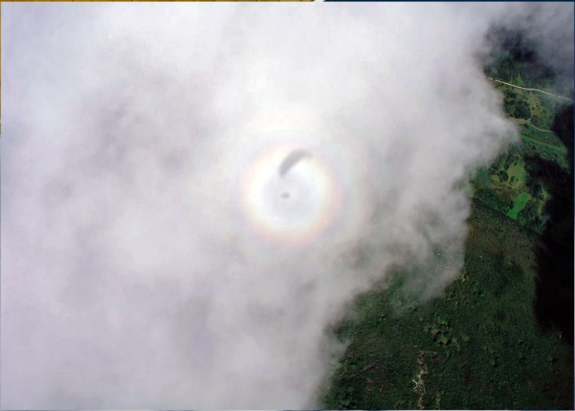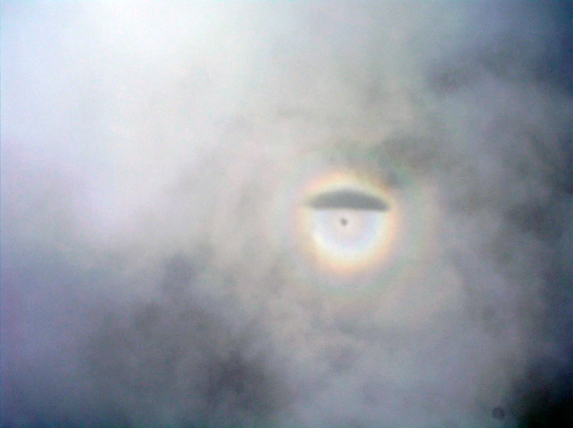Paraglider Glories
Paraglider Glories: A Fascinating Phenomenon in Atmospheric Optics
Paraglider glories, also known as glory rings, are captivating atmospheric optics phenomena that can be observed under specific conditions. While we often associate glories with aircraft shadows, balloon shadows, and other similar objects, paragliders offer a unique opportunity to witness this spectacle. However, caution must be exercised when attempting to observe paraglider glories. In this article, we will explore the formation and characteristics of paraglider glories in more detail.
The key requirement for the formation of paraglider glories is relatively strong sunshine coupled with mist or cloud beneath the observer in the direction opposite to the sun. This combination creates the ideal conditions for the phenomenon to occur. Paraglider glories form directly opposite the sun and are relatively small in size. The presence of a shadow is not essential for their observation, although it can sometimes aid in locating them, particularly when in an airplane.
Paraglider glories are formed due to the scattering of light by small water droplets present in mists, clouds, and fog. These droplets, which typically range in size from 1/1000 to 1/10 millimeters across, scatter light in all directions. When sunlight passes through these droplets in the same direction as its source, it creates a corona effect around the light source. Conversely, when light passes through the droplets in the opposite direction, it results in the formation of a diffraction-dominated version of a rainbow known as a fogbow. At the point directly opposite the sun, known as the antisolar point, the droplets backscatter light to produce the mesmerizing multicolored ringed glory.
Observing paraglider glories is not limited to real-life experiences; it can also be simulated and explored using computer software such as IRIS. This provides enthusiasts with the opportunity to experiment with different scenarios and gain a deeper understanding of the underlying physics behind this phenomenon.
In summary, paraglider glories are a captivating sight in atmospheric optics that can be witnessed under specific conditions. Here are some key points to remember about paraglider glories:
- They occur when there is relatively strong sunshine with mist or cloud beneath the observer in the direction away from the sun.
- Paraglider glories form directly opposite the sun and are relatively small in size.
- The presence of a shadow is not essential for their observation, but it can sometimes aid in locating them.
- Paraglider glories are formed due to the scattering of light by small water droplets present in mists, clouds, and fog.
- The droplets create a corona effect around the light source when sunlight passes through them in the same direction as its source.
- In the opposite direction, they form a diffraction-dominated version of a rainbow known as a fogbow.
- At the antisolar point, the droplets backscatter light to produce the multicolored ringed glory.
- Paraglider glories can also be simulated and explored using computer software like IRIS.
- Remember to exercise caution when attempting to observe paraglider glories during paragliding activities.
- By gaining a deeper understanding of paraglider glories, we can appreciate the beauty and complexity of atmospheric optics even more.
So, whether you're soaring through the sky in a paraglider or exploring the wonders of atmospheric optics from the comfort of your computer, paraglider glories offer a truly mesmerizing display that showcases the magic of light and nature.


Paraglider Glory ~ Imaged by �eljko Vranic over Istria, Croatia. Images ©�eljko Vranic, shown with permission.
We see glories around aircraft shadows, balloon shadows, glider shadows, those of mountaineers and hill walkers and even cruise passengers taking in the air at the ship�s rail. Paragliding provides a further opportunity but please take care!
The common feature is relatively strong sunshine with mist or cloud beneath you in the direction away from the sun.
The glory forms directly opposite the sun. It is small. The shadow is irrelevant except that it sometimes helps locate it when in an airplane.
The small water droplets (1/1000 to 1/10 mm across) of mists, cloud and fog scatter light in all directions. In the same direction as the sunlight they form a corona that appears around the light source. In the opposite direction they form the diffraction dominated version of a rainbow � a huge and diffuse fogbow. And at the antisolar point the droplets backscatter light to produce the much smaller multicoloured ringed glory.
By all means use a paraglider. But you can also produce all these effects and experiment with them on your PC by downloading IRIS!
Note: this article has been automatically converted from the old site and may not appear as intended. You can find the original article here.
Reference Atmospheric Optics
If you use any of the definitions, information, or data presented on Atmospheric Optics, please copy the link or reference below to properly credit us as the reference source. Thank you!
-
<a href="https://atoptics.co.uk/blog/paraglider-glories/">Paraglider Glories</a>
-
"Paraglider Glories". Atmospheric Optics. Accessed on November 26, 2024. https://atoptics.co.uk/blog/paraglider-glories/.
-
"Paraglider Glories". Atmospheric Optics, https://atoptics.co.uk/blog/paraglider-glories/. Accessed 26 November, 2024
-
Paraglider Glories. Atmospheric Optics. Retrieved from https://atoptics.co.uk/blog/paraglider-glories/.